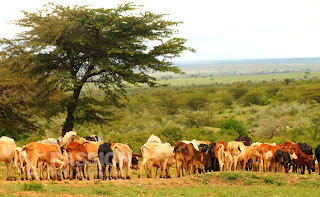"Hakuna Matata" is all that one can say about Masai Mara, meaning "No worries" in Swahili. Yes indeed, Masai Mara is a place which takes away all worries with its mesmerizing beauty and the wonderful creations, the splendid wildlife of Kenya. The Masai Mara National Reserve is one of the world's biggest wildlife reserves in the world with the widest species of wild animals. The Big Five Game is a phrase used to describe the five wildest animals. This name was used by the white hunters in ancient times, who came hunting for animals in Masai Mara. These are the toughest animals to be hunted on foot. They include African Lion, African Elephant, Cape Buffalo, Rhinoceros and Leopard. They are very frequently spotted during the peak season. Unfortunately, we were there during the off-peak season when most of the animals would have migrated to the Serengeti in Tanzania. Besides this, we were lucky enough to spot the big five, in small numbers though. After a long drive from Nakuru, we reached the Masai Mara National Reserve. For the first day'splan, we had an evening safari right after having lunch. It was a very cloudy day with frequent showers during the Safari. We spotted many elephants on the way. Just before leaving, we saw a pride of lions which had stopped for shelter inside a bush. There was a male lion which we could not see due to the thick bushes, though we saw its movement slightly. Most of them did not move because of the rain, except for one lioness, which came for a short round of walk and went back to its bush.
After the Safari, we came back to our lodge. We went for a stroll along the walkway at the backyard of the lodge. There was a bar beside a lake filled with Hippos. They were groaning inside the water. The already creepy place with the leafless trees became even more creepier with the noise of the Hippos. It was gettin darker when we saw a few birds of the night, owls and vultures. It was very dark, yet was able to take a few photos of them with long exposures. Owls are one of my favourite birds which i long to photograph in an extreme close up view. After a walk, we arrived at the hall right in time for dinner. It was accompanied by a performance by the Masai villagers, their traditional dance.
After relaxing at the reception for sometime, we decided to retire for the day and came back to our cottage. It was pitch dark with only one light source. The starry sky and the clouds looked very beautiful along with the trees. The situation seemed quite right for a long exposure photograph, which comes out very well in areas where there is no light pollution. Long exposure photography is my favorite types, but it is very unfortunate that I cannot try it very often due to the high light pollution level in the city which makes the photo very messed up. It is almost impossible to get a good shot. I tried taking for sometime with exposures as long as 3 minutes. Finally i got a few pictures after certain trials and errors.




















































































